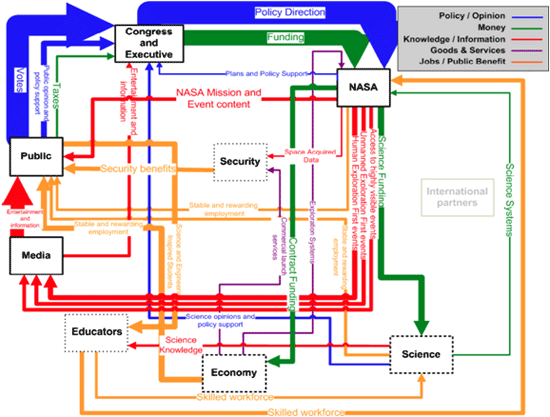Research
Stakeholder Analysis
In the design of complex systems serving a broad group of stakeholders, it can be difficult to prioritize objectives for the architecture. Stakeholder needs frequently conflict, challenging the idea that a single design can serve all needs. For example, in international joint ventures (such as between China and Bombardier with China Railway Highspeed), the host government aims to promote technology transfer and the foreign firm aims to gain access to new markets without divulging IP.
Stakeholder analysis aims to understand:
- Who are the firm's stakeholders?
- Which stakeholders deserve the firm's highest prioritization?
- How can we discriminate between potential architectures by understanding stakeholder needs?
- Which architectural decisions are central to product success?

We observe that many organizations fail to define stakeholder analysis beyond the process of soliciting requirements. We have advanced stakeholder value network models to map out the indirect benefit delivered to stakeholders. Consideration of value exchange enables the firm to prioritize its external stakeholders based on their importance to the firm, while constructing a network of stakeholder explicitly recognizes that many relationships are multi-party exchanges. We have developed a mathematical framework for this indirect generalized exchange [Cameron et al., 2011], which we have shown can be used to prioritize stakeholder needs in the context of value delivery to the network.
These methods have been applied to problems at BP, NASA [Cameron et al., 2011], ESA, China's National Energy System [Fu et al., 2011], and the Saudi Energy System. In a case study of a multibillion dollar facility [Feng et al., 2012], we showed that managers proposing a five-year expansion defined external relations activities only in terms of direct, bilateral negotiations with a limited set of stakeholders. Modeling the stakeholder network before and after the plant expansion proposal, we showed a network perspective would have flagged potential mitigation activities. Notably, the model's prioritization of stakeholders when constrained to only direct, bilateral relationships corresponded to the managerial prioritization of stakeholders. Using the network perspective, we proposed a possible causation mechanism for the subsequent negative public reaction to the proposed expansion.
The code for running a network analysis of stakeholders is available in JAVA (Download Stakeholder Code), together with an instruction manual. There is also a simple Excel-based tool available with limited functionality, click here for Mac or PC.




